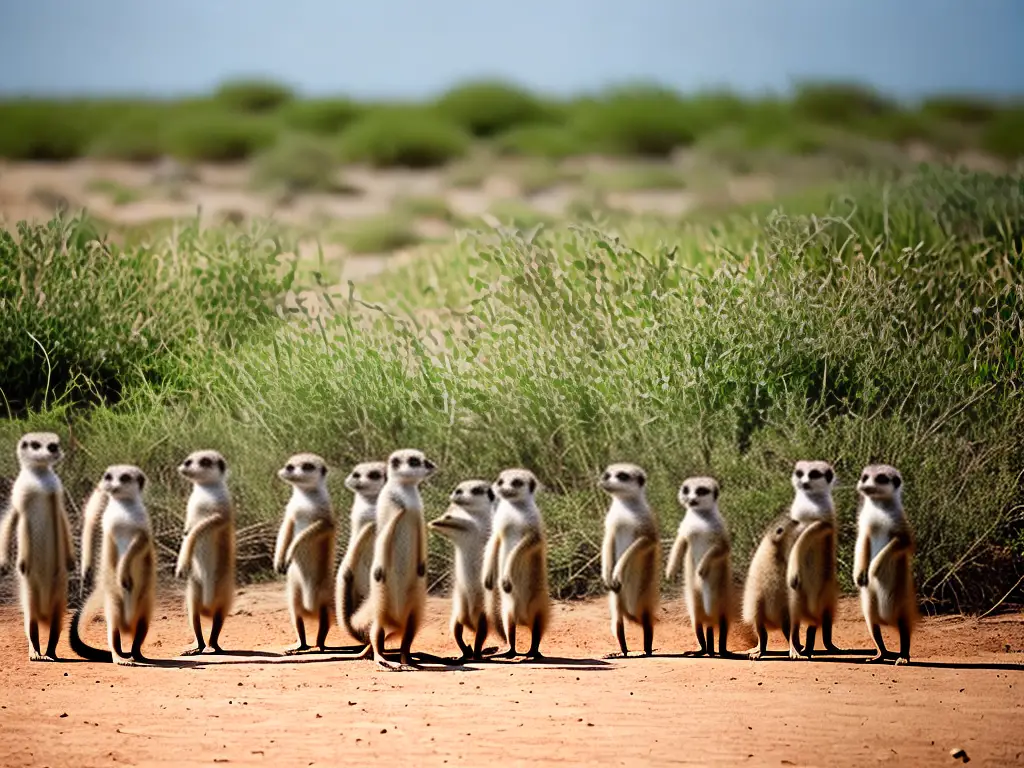Meerkats are small animals that belong to the mongoose family. They are also known as Suricates and are found mainly in the African Kalahari Desert. Meerkats have a slender body that can grow up to 12 inches long, with a tail that’s almost as long as their body. They are covered in a light brown fur with thin, parallel stripes on their back, which helps them blend into their surroundings.
One interesting physical characteristic of meerkats is their dark patches around their eyes, which help them reduce the glare from the sun like a pair of sunglasses, allowing them to see better during the day. They also have sharp, curved claws that are perfect for digging holes and burrows where they live and search for food. Meerkats mainly eat insects, but they can also consume other small animals, like lizards and rodents, as well as fruits and vegetables.
In their natural habitat, meerkats live in groups called ‘clans’ or ‘mobs,’ which can have up to 30 members. These groups are led by an alpha pair, usually the dominant male and female. Meerkats are known for their strong sense of community and cooperation – they work together to care for their young, forage for food, and watch out for predators like snakes, birds of prey, or other mammals that may try to attack them.
Meerkats are fascinating creatures, known for their unique social structure and behavior. They can live up to 12-14 years in the wild, but their life expectancy is influenced by factors such as habitat, availability of food, and the presence of predators. To ensure their survival and maintain the health of the ecosystem they inhabit, it is crucial to learn more about these wonderful animals and protect their natural environment.
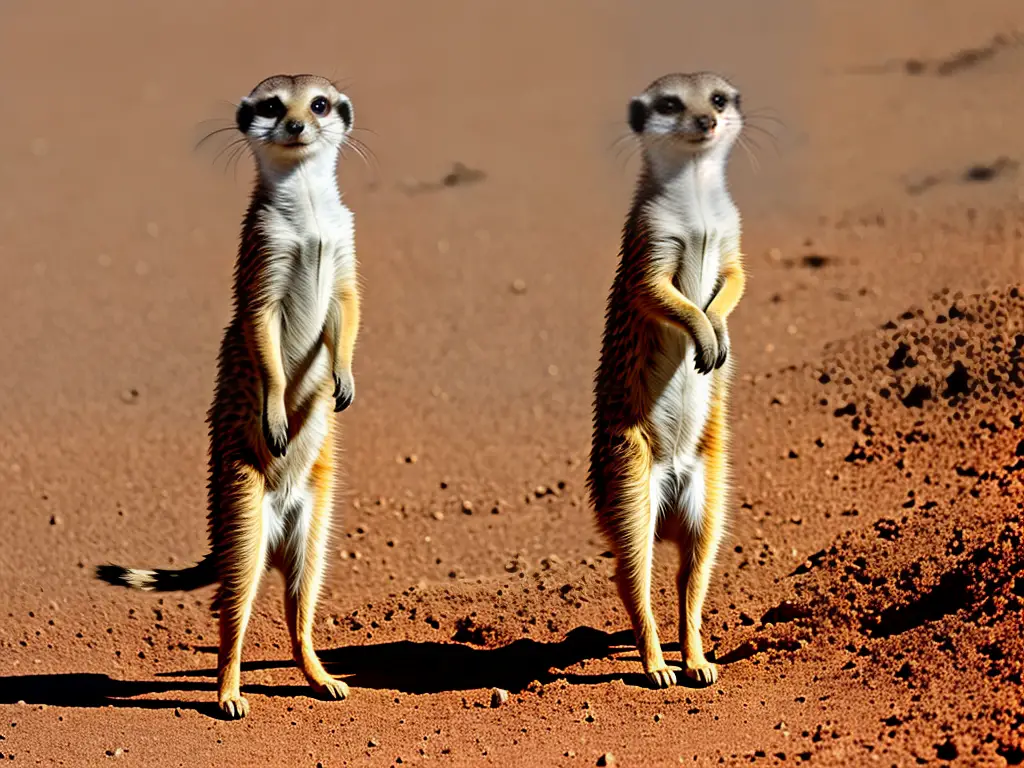
Living in large groups called clans, mobs, or gangs, meerkats exhibit complex social behavior that plays a pivotal role in their survival. These groups are typically led by a dominant male and female pair who are responsible for making important decisions. They navigate the challenges of living in the wild by determining where to find food and when to move to a new location, ultimately affecting the life expectancy of their clan members.
The rest of the group is made up of both males and females, with each animal having its own unique role within the clan. Some of these roles include babysitters, who look after the young meerkats, and sentinels, who keep a watchful eye out for predators. When meerkats are foraging for food, one of the sentinels will stand on its hind legs and scan their surroundings, making sure everything is safe for its family members.
Meerkats communicate with each other through a variety of sounds and body language. They have different alarm calls for different types of predators, and the entire group quickly responds, working together to make sure their clan stays safe. When a sentinel spots a threat, it will let out a high-pitched, panicked call, which alerts the rest of the group. The meerkats will then rush to their burrow, where they can hide from the danger.
Meerkats are small, furry animals that live in the deserts of Africa. Their life is centered around their clan, with each animal working together to ensure their survival. Meerkats are known for their unique diet and foraging techniques which help them live in the harsh desert environment they call home.
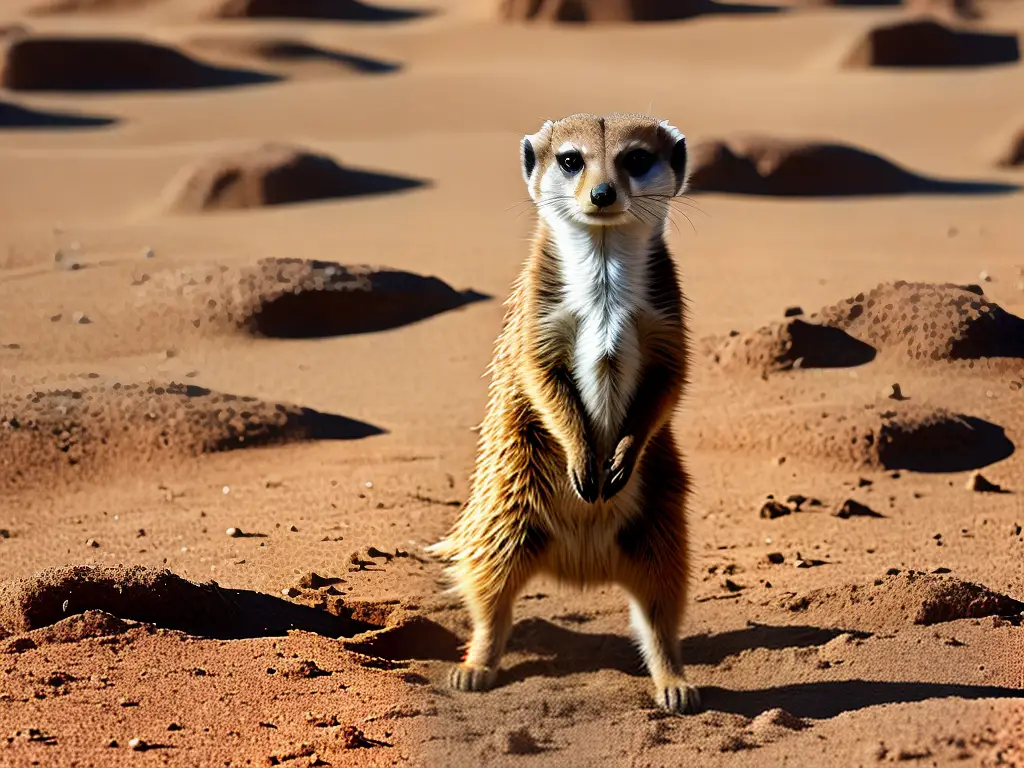
The complex social structure of meerkats allows them to efficiently communicate and cooperate. To find food, they use their long, sharp claws to dig into the ground and uncover insects, like beetles and locusts, as well as other small creatures like spiders, scorpions, and centipedes. Meerkats also eat small reptiles like lizards and geckos, and sometimes snack on plants, fruits, and roots.
When it comes to foraging, meerkats are very social creatures. They often work together in their groups, known as mobs or clans, to search for food. This teamwork helps them to cover more ground and find more food for everyone in the group. While some meerkats are busy digging and searching for food, others will keep a lookout for predators like eagles, snakes, or jackals that might try to attack the group while they are distracted.
Because meerkats live in a harsh desert environment where food can be scarce, their foraging skills are very important. They can dig up to 5 feet in the ground with their claws to find their prey, and their keen sense of smell helps them to track down food sources like insect larvae and hidden animals. They can also move large amounts of sand at a time, which helps them uncover hidden food quickly.
Meerkats are small mammals that live in the grasslands and deserts of southern Africa. They are social creatures and live in large groups called ‘clans’ or ‘mobs’. These animals have a fascinating reproduction process and life cycle, which begins with mating. Meerkats typically mate during the warmer months, and the dominant male and female in each group will be the primary parents.
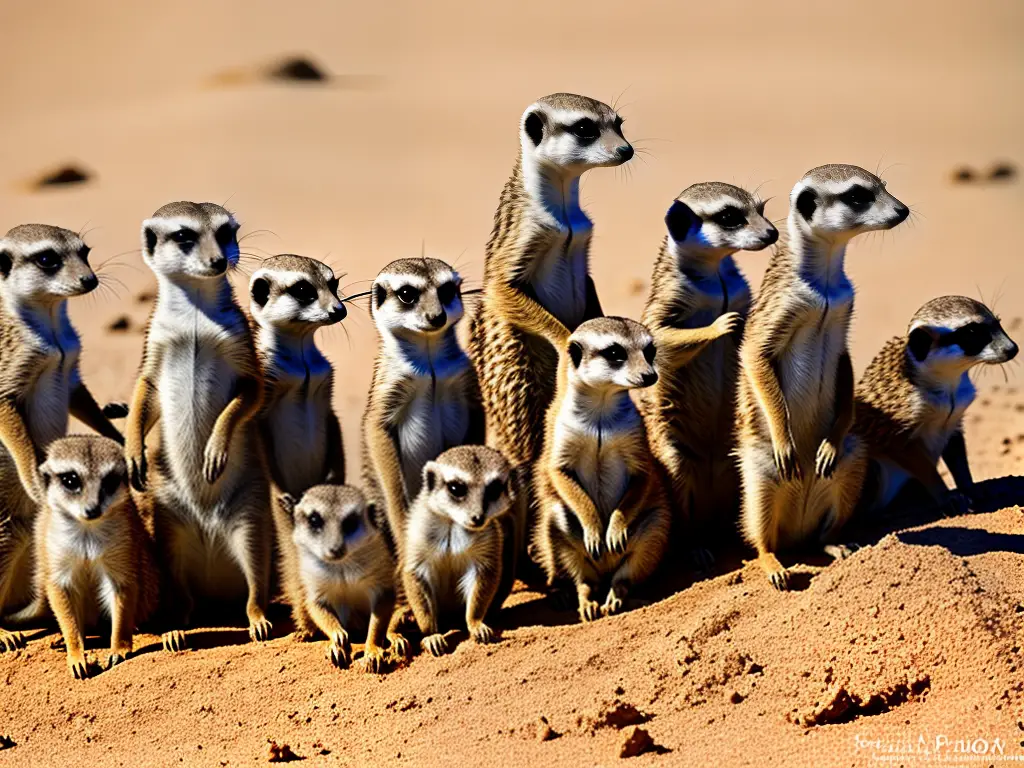
Overall, meerkats have adapted well to their desert homes, where they need to be resourceful and efficient to find enough food to survive. Their excellent foraging skills, strong social bonds, and ability to work together make them fierce little hunters and give them a better chance at living a long, healthy life in the challenging environment. This unique combination of adaptability and social structure in meerkats contributes to their life expectancy and ability to thrive in their natural habitat.
After a gestation period of about 11 weeks, the female meerkat gives birth to a litter of two to five babies, called ‘pups’. Meerkat pups are born hairless, blind, and completely dependent on their mother for care. During the first three weeks of their life, the pups stay inside the safety of the burrow, where the other clan members help to care for them.
As meerkat pups grow, they begin to venture out of the burrow and learn important skills for survival in the wild. By the age of four weeks, they have developed enough to start leaving the burrow to accompany their family members on foraging outings. Meerkat pups learn to hunt and catch insects and small animals, and they also rely on adult meerkats to teach them about potential dangers in their environment, such as predators.
Meerkats are small mammals that live in the grasslands of Africa, reaching adulthood at around one year of age. They are known for their social behavior, living in groups called mobs or gangs, and participate in various duties throughout their lives, such as standing guard, caring for pups, and foraging for food.
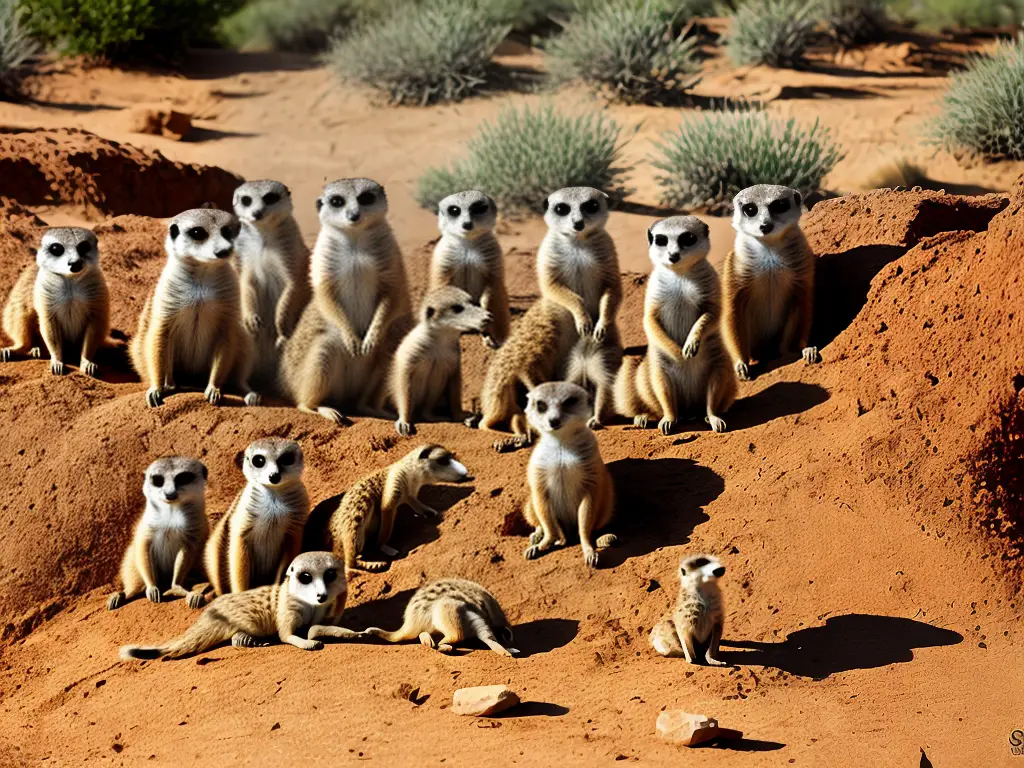
As they grow older, meerkats reach breeding age at around two years old. Their life expectancy in the wild is about 12 to 14 years, but they can live longer in captivity. With their curious and playful nature, meerkats also need to be cautious and alert, as they face many predators and threats in their environment.
One of the main predators of meerkats are birds of prey, such as eagles and hawks. These powerful birds can quickly swoop down from the sky and snatch an unsuspecting meerkat. To avoid becoming an easy meal, meerkats need to be constantly on the lookout for these aerial hunters. They often assign a ‘sentry’, or guard, to watch out for any signs of danger while the others forage for food.
Snakes are another important threat to meerkats. Some of the snakes that share their habitat, like the Cape cobra and puff adder, are venomous and can pose a serious risk. When a snake is spotted, meerkats work together to harass and intimidate the snake, making high-pitched alarm calls to warn the rest of the group. They may even attack the snake in an effort to drive it away from their territory.
Meerkats are fascinating animals that live in the Kalahari Desert in Africa. In addition to predators, they must also be careful of other potential dangers, such as rough weather conditions and human activities. Extreme heat, cold or drought can make it difficult for them to find enough food and water, while human activities like farming and development can destroy their habitats. However, meerkats are resilient creatures and have learned to adapt to many of these challenges in order to survive in the wild.
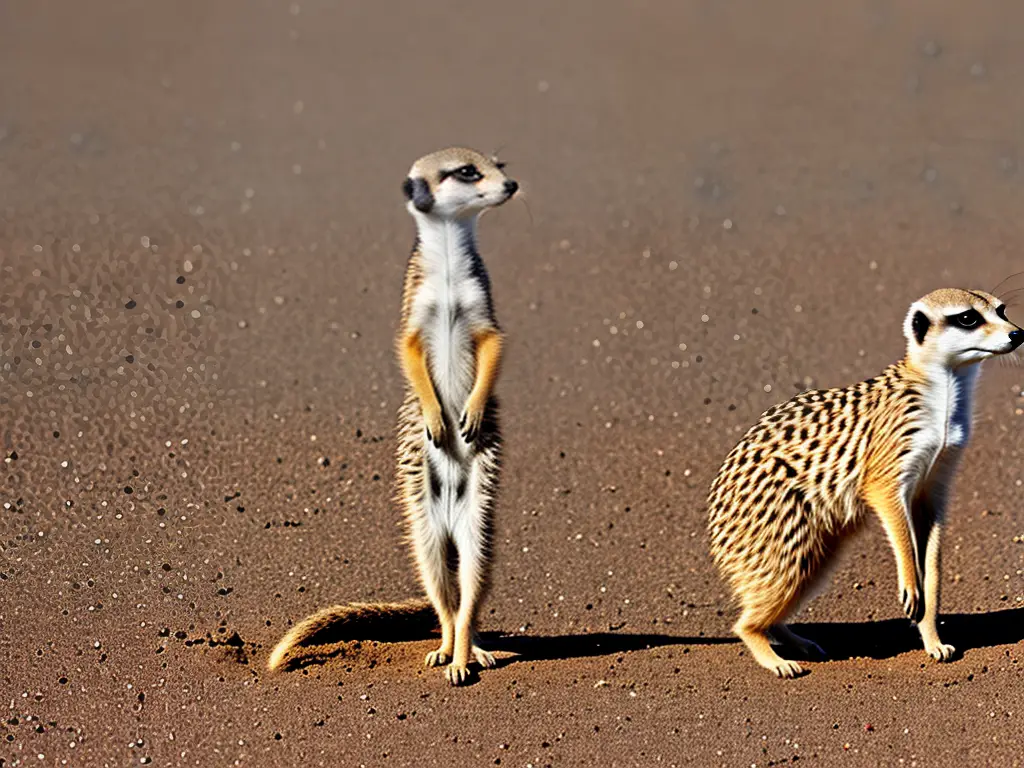
Human interaction with meerkats can have both positive and negative impacts on their lives. For example, humans may help protect meerkats and their habitats by supporting conservation efforts. However, they can also cause harm through habitat destruction and negative encounters with meerkats in the wild. Understanding these factors and the challenges faced by meerkats can be essential in preserving their habitats and ensuring their life expectancy remains stable.
Meerkats have a conservation status of ‘Least Concern,’ which means they are not currently in danger of becoming extinct. However, their populations could be affected if they lose more of their natural habitat due to human activities, such as farming, mining, and construction. Additionally, illegal pet trade can also harm meerkat populations by taking them out of their natural environment and into homes where they may not be cared for properly.
Human efforts to protect meerkat habitats are crucial for maintaining their population levels. By working with organizations like the Meerkat Magic Conservation Project, humans can help conduct research and educate the public about the importance of meerkats and their habitats. This will help ensure that these amazing creatures can continue to flourish in their natural environments, without human interference putting their existence at risk.
In conclusion, humans play a significant role in meerkats’ lives, both positively and negatively. It is important for us to work towards better understanding these animals and preserving their habitats to ensure that future generations can enjoy the beauty and uniqueness of these fascinating little creatures. Through conservation efforts and responsible interaction, we can help maintain healthy populations of meerkats and protect their natural environments for years to come.
